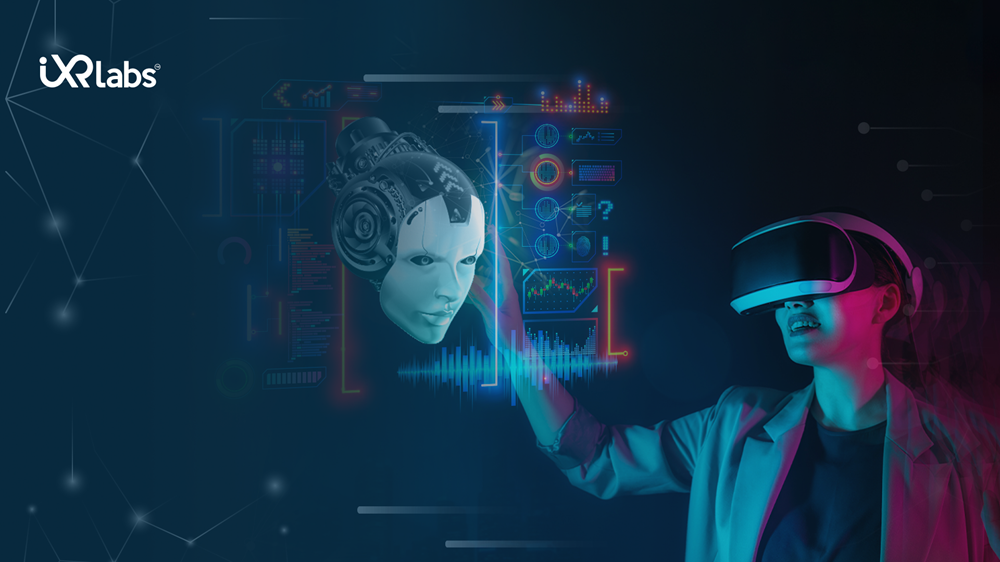Why are Artificial Intelligence and Virtual Reality the Perfect XR Pair?

In the midst of turbulent times for the Metaverse, artificial intelligence (AI) and virtual reality (VR) are poised to surge in popularity. Despite their distinct natures, these emerging technologies synergistically deepen the bond between humanity and the digital realm.
On one hand, Virtual reality harnesses a fusion of hardware and software to transport users into captivating digital environments, enabling a wide array of applications such as learning, entertainment, and therapy.
While on the other, artificial intelligence serves as the driving force behind groundbreaking advancements that analyze, respond, and create based on vast data sources.
With ongoing investments by tech companies, VR and AI are forging closer ties, collaborating to revolutionize computer vision across the industry.
By incorporating artificial intelligence, tech firms empower computer
systems to perceive and comprehend human actions and movements within physical
or virtual spaces. This integration significantly expedites the processing of
intricate motions and enables sophisticated analytics.
As the trajectory of Artificial Intelligence and VR converges, the potential for
transformative innovations across diverse domains grows exponentially,
captivating audiences worldwide.
Fusion of VR and AI
_14377.jpg)
In the healthcare sector, AI virtual assistants have become invaluable tools, guiding people through virtual environments and providing real-time medical attention, advice, and documentation.
Dubai's Ministry of
Health and Prevention (MOHAP) has taken a leap forward by incorporating virtual
and real assistants on its metaverse healthcare portal.
This innovative approach allows visitors to receive personalized
care with the help of both human staff and AI-powered chatbots. Whether it's
seeking medical attention or obtaining crucial health information, individuals
can now do so efficiently and conveniently within the immersive space.
Similarly, the travel and tourism industry has embraced the
integration of AI and VR by launching national metaverse portals. These portals
offer AI-assisted chats that enable users to interact and obtain essential
information regarding visas, passport renewals, and updated country details.
By utilizing cross-platform tools, travelers can access
crucial travel documents and receive key information, ensuring a seamless and
hassle-free experience.
Retail is another sector that has been positively impacted
by the fusion of AI and VR. The customer experience has been elevated to new
heights with the introduction of AR (Augmented Reality) try-on technologies.
Shoppers can now virtually try on clothing items before visiting physical
stores, significantly reducing the likelihood of returns and enhancing overall
customer satisfaction.
Companies like Reactive Reality have also harnessed this
technology to help retail firms meet sustainable development goals by
minimizing overproduction.
Notable retail giants such as IKEA and Amazon have
capitalized on the AI and VR fusion to optimize their operations and improve
customer satisfaction.
Through virtual overlays, customers can superimpose
virtual furniture, electronics, and clothing stocks onto physical locations.
This feature ensures that customers can visualize how these
products would fit into their spaces accurately. Moreover, AI algorithms
enhance the retail experience by suggesting similar products that complement
customers' purchases, providing a personalized touch and encouraging further
exploration.
The fusion of AI and VR is a testament to the potential of
technological innovation. From healthcare and travel to retail, this powerful
combination has created new avenues for immersive experiences, improved
efficiency, and enhanced customer satisfaction.
As we move forward, it's exciting to envision the limitless possibilities that await us in this ever-evolving landscape.
Also read: VR Education: Top 10 Reasons to Include VR in Higher Education
Making VR more intelligent
_46884.jpg)
While VR has already made significant strides in delivering immersive experiences, AI brings a new level of intelligence and sophistication to enhance collaboration, human-computer interfacing (HCI), and overall performance.
Here is how AI is being integrated into VR technologies, paving
the way for more intelligent virtual experiences.
Boosting Collaboration and HCI
AI-powered advancements have enabled companies like Morpheus and Microsoft to enhance collaboration among colleagues in VR environments.
By leveraging AI, these companies have introduced features such
as AI-backed eye contact and real-time interactions with avatars. This
technology creates a more natural and engaging virtual meeting experience,
bridging the gap between remote teams and boosting productivity.
Foveated Rendering for Optimal Performance
VR headset manufacturers like Varjo, Magic Leap, Meta, Pico, and HTC VIVE are harnessing the power of AI to implement foveated rendering.
This technique optimizes performance and extends battery life by rendering
high-resolution images only in the user's focal point. By tracking the user's
gaze and rendering graphics accordingly, AI ensures that computational
resources are utilized efficiently, resulting in a more immersive and visually
stunning experience.
Insights into Human Behavior with Attention
Tracking
Integrating AI and attention-tracking technology opens up
new possibilities for understanding human behavior within VR environments.
Companies like CORETXR, Tobii, Varjo, and potentially ARuVR leverage AI to gain
valuable insights into how users interact with creative content. T
hese AI-powered solutions enable businesses to refine their
virtual experiences by analyzing real-time precision data on attention and
behavior, improving user engagement and satisfaction.
Generative AI for On-the-Fly Creative Content
The emergence of generative AI tools has had a profound impact on the XR (Extended Reality) industry. NVIDIA's Omniverse platform, for example, has incorporated generative AI to enable real-time creation and manipulation of virtual content.
By leveraging AI algorithms, XR companies can dynamically generate and modify environments, objects, and textures, leading to limitless creative possibilities and immersive experiences.
Also read: Why Haptic Feedback is Crucial for VR Education?
Conclusion
In conclusion, the integration of artificial intelligence (AI) and virtual reality (VR) has unlocked new possibilities, as seen with companies like Microsoft, Google, Meta, and others adopting Chat GPT 3.5 and Gen AI.
This synergy allows for the on-the-fly creation of backgrounds,
environments, and training modules, revolutionizing world-building and learning
experiences.
The combined usage of AI and VR enhances their individual
capabilities, promising even more impressive advancements in the future.
The convergence of these emerging technologies holds immense potential, transforming industries and shaping a future where immersive experiences and intelligent interactions are the norms.
The fusion of AI (Artificial Intelligence) and VR (Virtual Reality) has opened up a world of possibilities across various industries, revolutionizing the way we interact, communicate, and experience the virtual realm.
This powerful combination has proven to be a game-changer, enhancing sectors such as travel, tourism, healthcare, and retail, among others.

.png)
.png)


.png)